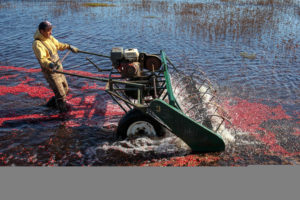
The cranberry harvest always starts with a flood.
Each fall, after bright sun and cold nights transform the fruits from green to ruby red, cranberry farmers inundate their bogs, submerging the berries in knee-high water. Working in teams, wader-clad farmworkers push “egg beaters”—wheeled water reels that look like giant whisks—through the water. The beaters shake the fruit loose from vines, freeing the hollow berries to drift to the surface and float.
On a chilly day in October, the harvest team fanned out across the bog at Pine Island Cranberry Farm in Chatsworth, New Jersey, trails of berries floating in their wake.
The rafts of floating berries, stark against the still water and the green of the New Jersey Pine Barrens, make for a compelling photo opportunity. (Cranberry farmers have recognized this, and the grower cooperative Ocean Spray films advertisements during the harvest. Actors stand in for the farmhands
But far from being an ecological necessity, the flood is actually part of a labor-saving harvest method invented sometime around the middle of the 20th century. Dry-harvesting cranberries is backbreaking work. The vines are low to the ground, and the berries grow in layers beneath a canopy of leaves. Farmers realized they could cut costs significantly by using machines to dislodge the fruit. Water did the rest of the work.
On the day I visited Pine Island, the harvest was in full swing. Workers pushed egg beaters through one bog while a Rube Goldberg-type system of tubes and pumps vacuumed berries out of the water and spat them into a waiting truck bed nearby. Once full, the truck drove the freshly picked berries a few miles down the road to the receiving center, where they were sorted and graded.
By H. Claire Brown